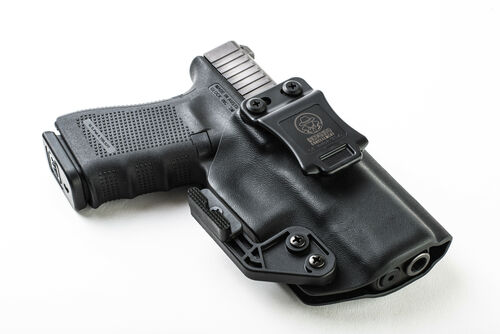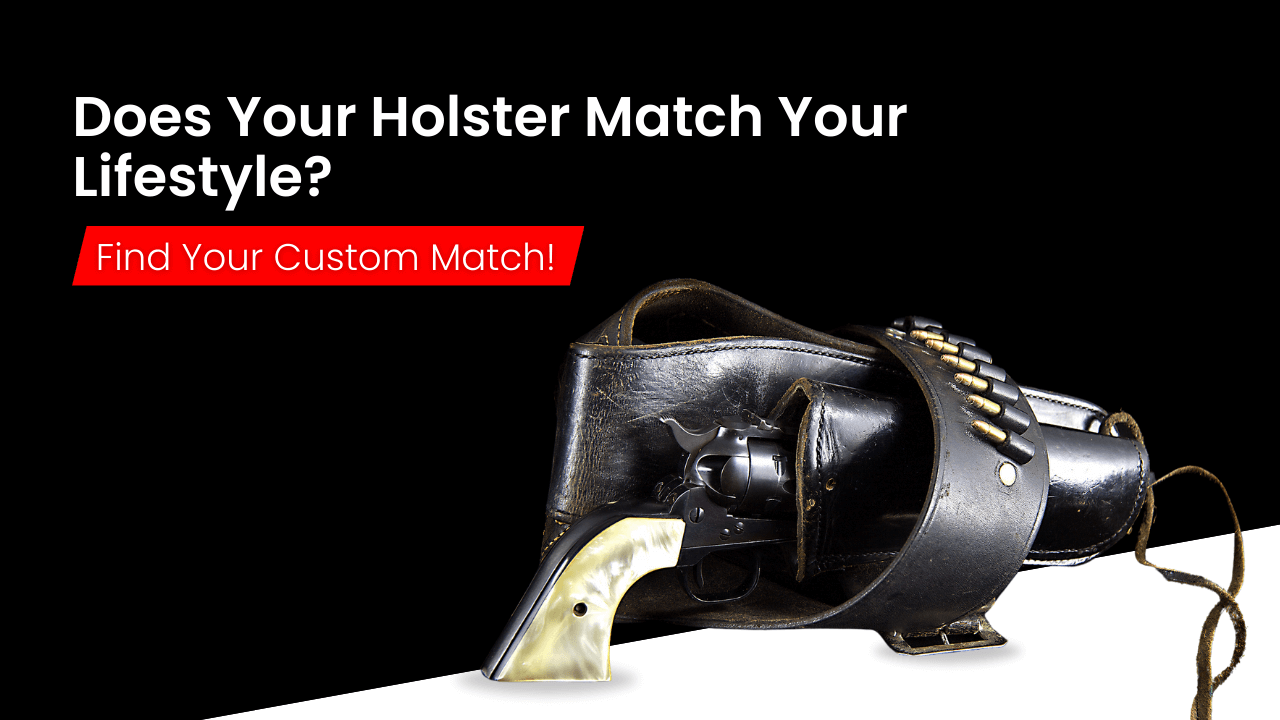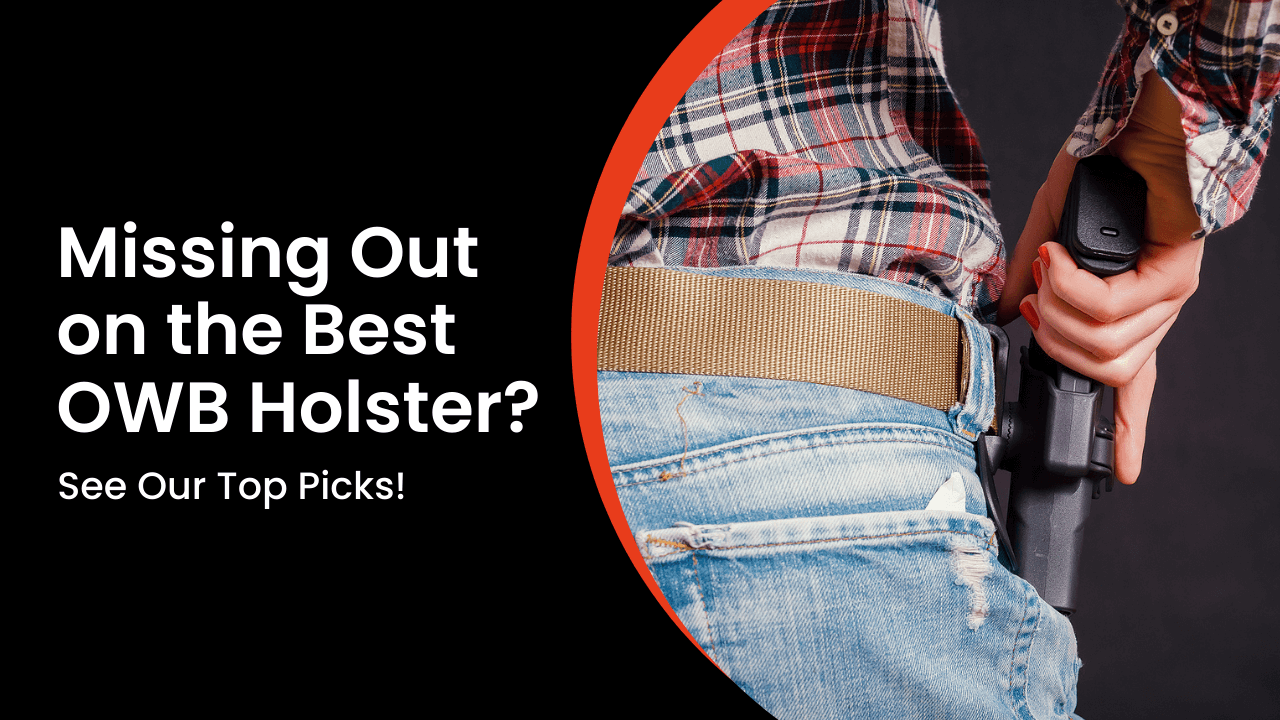Glock 48 Holster: IWB vs. OWB Pros and Cons
Sep 5th 2021

If you’re interested in carrying a Glock 48, you need to decide whether to conceal carry or open carry. Waistband holsters fall into two categories: OWB (outside the waistband) and IWB (inside the waistband). Understanding the strengths and weaknesses of both systems can allow you to make an informed decision regarding your choice of holster.
The Glock 48 Pistol
The Glock 48 is a compact 9mm semi-automatic pistol fed from a single-stack 10-round magazine. This allows the use of the Slimline frame, which is 1.10” compared with the Glock 19’s 1.26”. The height of the two pistols is identical.
While the difference between the two in overall length is minimal (7.28” vs. 7.36”), the G48 has a slightly longer barrel (4.17” vs. 4.02”). When fully loaded, the G48 is five ounces lighter because of its reduced magazine capacity.
As a result of these differences, the G48 offers a balanced package for concealed or open carry.
Waistband Carry
If you decide you want to carry a concealed handgun, waistband carry is the most popular option. Waistband-carry positions provide reasonable access, concealment, and control, all necessary for handling a defensive weapon.
Positions and Strong Side Carry
Where you place the handgun on your waistband is usually expressed using references to hour-hand positions on a clock face. For example, strong-side carry, also known as hip carry, is at 3 o’clock for a right-handed shooter.
In strong-side carry, the holster is on the side of the pelvis that corresponds to your dominant hand. While 3 o’clock would place the holster directly over the hip bone, many gun owners prefer to carry the gun behind the hip, which would be 4 or 5 o’clock.

Appendix Carry
While strong-side carry is one of the most popular carry positions, you can also consider appendix carry. In appendix carry, you place the gun holster between your dominant-side hip and your navel.
Using the clock face metaphor, this could range between 12 and 2 o’clock. Appendix carry is somewhat controversial because it causes the muzzle to cover the genitalia and femoral artery, although highly concealable and fast.
As a result, you must practice firearms safety diligently and select a holster with a fully enclosed trigger guard and rigid holster mouth. In addition, when re-holstering your firearm, always return your weapon slowly and methodically. There’s no reason to re-holster your weapon quickly. If you need to re-holster your weapon, that indicates the threat has passed.
IWB Holsters
IWB (inside the waistband) is a carry method in which the gun owner places the holster between the waistband of the pants and the body. The holster attaches to the belt using clips, which are plastic or metal fasteners. There are also clips designed to attach directly to the hem of the pants, bypassing the need for a separate gun belt.
Advantages of IWB
The advantages of IWB holsters include:
Concealability
The primary advantage of carrying IWB is concealability. Less of the weapon is exposed as the gun holster is partially hidden by the pants below the waistband. This is ideal for the deep concealment of compact handguns, such as the G48. It’s also easier to conceal an IWB holster for the same reason.
Versatility
IWB is also more versatile because it’s less restrictive to your wardrobe options or in different climates. You don’t need to wear additional clothing to conceal your weapon, so IWB carry is more adaptable to summer and the more humid regions of the country.
Tuckable Holsters
When a holster is tuckable, you’re able to tuck the fabric of your shirt over the holster and into a space between the holster and the belt clip. The result is that the holster is completely concealed. Only the belt clips remain visible.
If you need to adhere to a specific dress code that requires you to wear a tucked-in shirt, this is a viable carry option. Keep in mind; however, you will need to practice your draw stroke. Instead of sweeping away clothing, you’ll need to apply more upward force to expose your weapon.
Disadvantages of IWB
IWB holsters have their drawbacks:
Clothing Size
IWB holsters require sufficient space inside your pants to be comfortable, so you may need to change the pants size you typically wear. Many gun owners choose a size up to accommodate the additional bulk of the holster and firearm. In a Kydex holster, which is less compressible than leather, IWB can be uncomfortable for some people.
Weapon Type
IWB is also more suitable for compact and subcompact handguns. This is less convenient, although you can carry full-size combat handguns, such as the M1911A1 pattern and Beretta 92FS, in an IWB holster.
OWB Holsters
In contrast to IWB holsters, outside the waistband (OWB) holsters involve external placement. This is your traditional belt holster, attaching to your gun belt via integral loops or separate clips.
Advantages of OWB
The advantages of OWB holsters are:
More Comfortable
OWB holsters are generally considered more comfortable to wear than IWB holsters, especially when the holster is composed of a hard thermoplastic because it’s not pressed firmly against the body.
Ideal for Open Carry
If you intend to carry your firearm openly, OWB is the more appropriate choice. There’s no reason to carry inside the waistband if you don’t want to conceal your weapon.
No Weapon Restrictions
IWB is compatible with many firearm types; however, the most comfortable handguns to carry inside the waistband are compact and subcompact weapons. OWB holsters are suitable for handguns of every size, weight, and caliber.
Disadvantages of OWB
The cons of OWB holsters include:
Decreased Concealability
The first downside to OWB carry is it’s harder to conceal than IWB. Because OWB holsters are external and don’t tend to hold as firmly against the body, they’re more likely to print through clothing. As a result, the holster, gun belt, weapon, and clothing must all work together to minimize disclosure.
More Restrictive Regarding Clothing
To effectively conceal your firearm using an OWB holster, you’ll need to wear a separate article of clothing like a jacket, coat, or vest. Whatever it is, it must drape over and hide your weapon. During the summer months or in particularly hot and arid environments, this can be a liability.
Necessary Requirements for All Holsters
Regardless of whether you choose an IWB or OWB holster, your holster should provide sufficient retention to keep the weapon securely in place, a covered trigger guard to reduce the risk of an accidental discharge, and a durably constructed design to resist wear and collapse when you draw your firearm.
Ideally, you should experiment with both IWB and OWB holsters to see which type you feel most comfortable using. Each individual is different, and there’s no one-size-fits-all option with concealed-carry holsters. Adjustable retention, ride height, and cant allows you to find the perfect balance between concealability, accessibility, and draw stroke.
Incognito Concealment OWB and IWB Holsters
If you’re looking for an OWB or IWB holster for your Glock 48 handgun, Incognito Concealment manufactures high-quality, American-made, and hand-molded products to meet the demands of concealed carriers. Give us a call at (586) 333-4240, and we’ll help you find the holster that’s right for you and your weapon.











